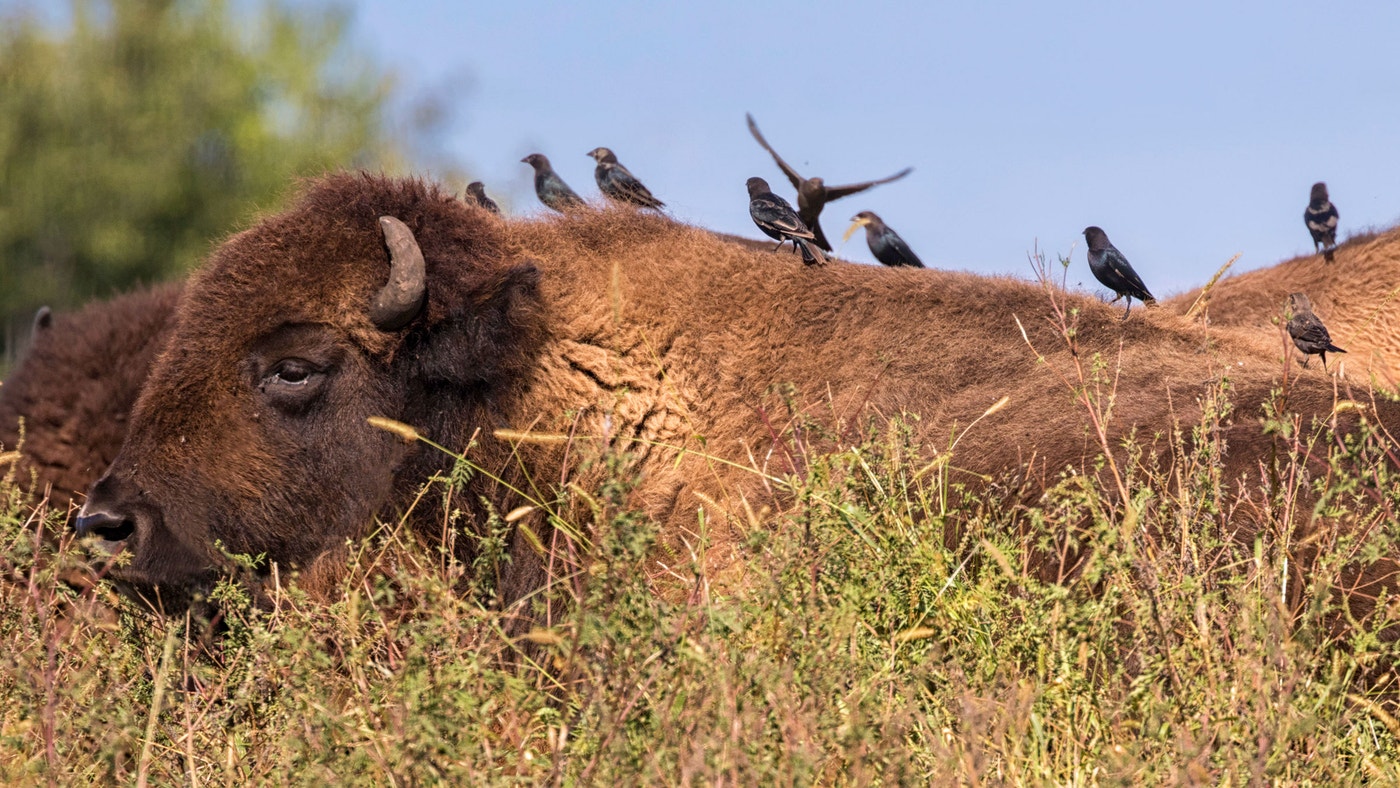
Standing six feet high at the shoulder and weighing as much as 2,400 pounds, an American bison is a force of nature on its own. In a herd? “They’re ecosystem engineers,” says Jason Baldes, tribal buffalo program manager for the National Wildlife Federation and a member of the Eastern Shoshone Tribe from the Wind River Indian Reservation in Wyoming.
A healthy source of disturbance to dynamic grasslands, American bison—or buffalo, a name traced back to French fur trappers and used by the Lakota, the Shoshone, and other Native nations who have lived alongside the animals for centuries—alter the landscape in myriad ways. From caught in their shaggy fur to creating shallow depressions as they roll in the dirt, which can fill with water and provide valuable habitat, the massive mammals help support diverse communities of plants and animals, including many birds.
“We have a hard time fathoming what the landscape might have looked like with buffalo in great numbers,” Baldes says. Tens of millions of them once roved the continent, but westward expansion by Euro-American settlers and a U.S. Army-led aimed at eradicating Native nations left only a few hundred wild bison by the late 19th century. Today hundreds of thousands are farmed for meat, but so few roam free—only about , mostly in carefully managed herds on tribal reservations and federal land—that they are considered functionally extinct, meaning there aren’t enough left to fill their ecological role. Western landscapes are more likely to be grazed by cattle, domesticated grazers that from the ancestors of American bison around 2 million years ago.
Leading the push to revitalize bison are Indigenous groups such as the , which has been at work on the issue for more than 30 years. Those efforts are set to get a boost: Earlier this year, the U.S. Department of the Interior to restoring bison, along with a one-time investment of $25 million from the Inflation Reduction Act. The move intentionally centers tribal management, in recognition of both the traditional significance of buffalo and the legacy of harmful federal policy. “It’s not just a Native American story, though,” Baldes says. “It’s an American story.” By preserving biodiversity and traditional knowledge, “What we’re working to do is to protect all of us.”
The new federal investment is a step in the right direction, Baldes says, but he’d like to see the funding for tribal herds and research made permanent. A bill to do just that, the , passed in the House in 2021 but stalled out in the Senate. “The cultural importance is reason enough to bring them back,” Baldes says. “Also reason enough is that they are keystone species.”
Because they play such an important ecological role, a meaningful bison rebound would change the grasslands in ways both large and small, and the direct beneficiaries would include many avian species. Here are five ways that more bison on the landscape would be a boon for birds.
Bug Buffet
Insect-loving Black-billed Magpies often hitch a ride—and find a meal—on the hairy backs of bison. The symbiotic relationship benefits both bird and mammal: One gets nutrition, and the other is rid of irritating hitchhikers. Brown-headed Cowbirds also like to hang around bison, feeding on insects they stir up while grazing. Baldes points out that, here in North America, “cowbird” is something of a misnomer. “That should be buffalobird,” he says.
Desirable Dung
Roaming bison enrich the soil with their droppings, but some grassland birds find a more immediate use for the leavings. Long-billed Curlews like to build their nests beside conspicuous objects on the landscape, perhaps to shade or hide them. Buffalo dung is just the right shape, says Andy Boyce, a research ecologist at the Smithsonian Migratory Bird Center who studies grassland birds. Burrowing Owls are also picking up what buffalo are putting down: They , including from bison, perhaps to lure in tasty dung beetles.
Meandering Mowers
A hungry bison’s favorite meal is wild grass. “They graze it down pretty short,” says Daniel Kinsey, instructor and project director at Aaniih Nakoda College on the Fort Belknap Indian Reservation in Montana, which maintains two buffalo herds for cultural use and ecological research. “That creates really good habitat for a lot of the short-grass prairie birds,” Kinsey says, including Horned Lark and Thick-billed Longspur.
But free-ranging bison don’t stay put. As they roam, they heavily graze some patches while leaving other areas untouched for years, letting grass grow taller. (The idea behind łÔąĎşÚÁĎ’s Conservation Ranching Initiative is for livestock producers to mimic buffalo herds by moving cattle—and sometimes bison—around their land.) “The difference between grass that’s two inches high versus six inches high is not that meaningful to us, but to birds it is,” Boyce says. Longer, denser grass is perfect for species like Baird’s Sparrow for building their highly concealed nests.
Shrub Stoppers
Although they don’t eat trees or tough shrubs, bison likely help prevent these tenacious plants from encroaching on delicate grassland habitat, according to Boyce. How do they do it? “Bison are furiously itchy at all times,” he says. They’ll take any opportunity to scratch their backs and flanks on something tough, destroying the woody plants in the process. That’s good news for grassland specialists, such as Sprague’s Pipit and Chestnut-collared Longspur, that avoid trees and shrubs, which tend to harbor predators. “Just one or two trees can make habitat unsuitable for these species,” Boyce says.
Recovering Rivers
Compared to domesticated cattle—the bovine grazers that today vastly outnumber bison in the United States—buffalo tend to be less destructive to sensitive waterways. They prefer grasses found in the uplands to the forbs that grow beside rivers and streams. They are also naturally much more tolerant of heat, meaning herds of bison are less likely than cows to go for a cooling swim and tear up the river habitat in the process. The healthier riparian areas in bison-grazed lands better support water-loving birds like Yellow Warbler, Bullock’s Oriole, and Eastern Kingbird.

